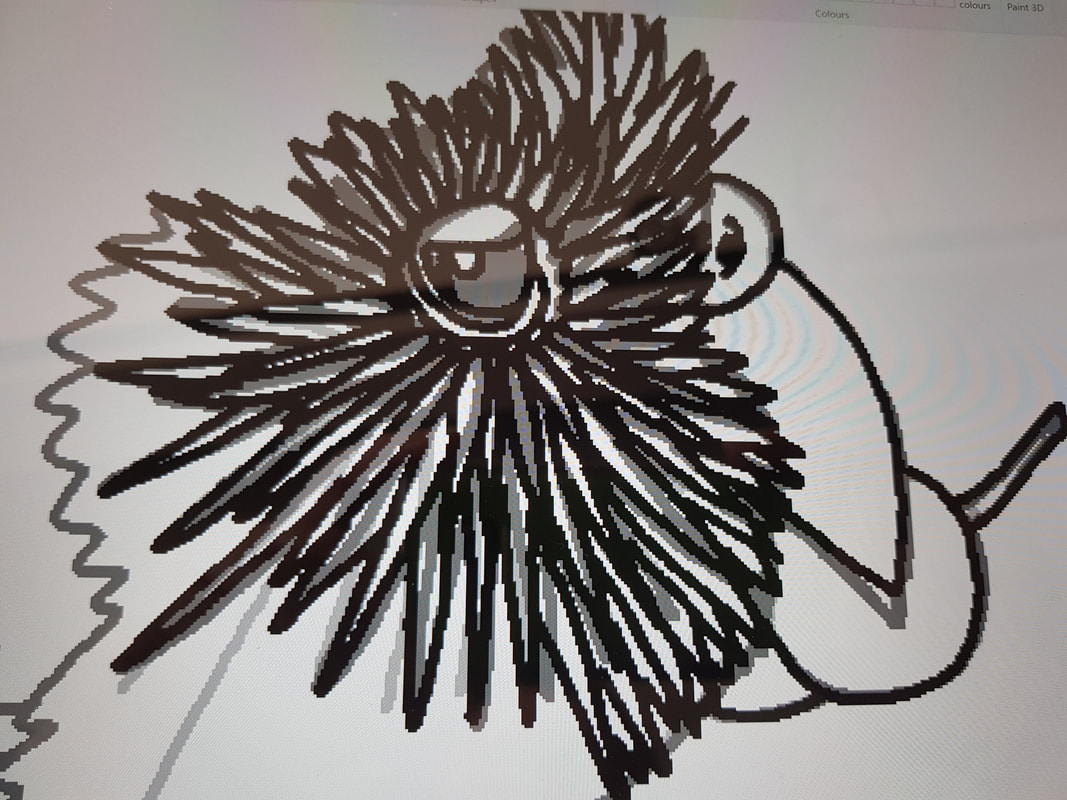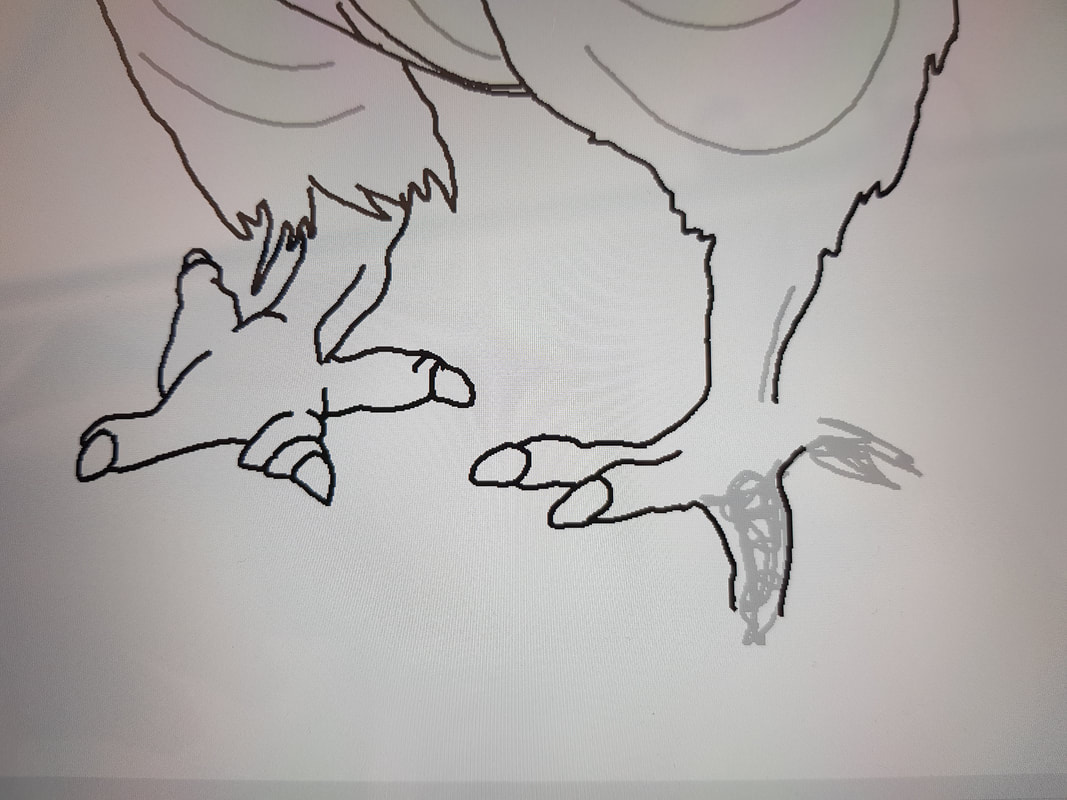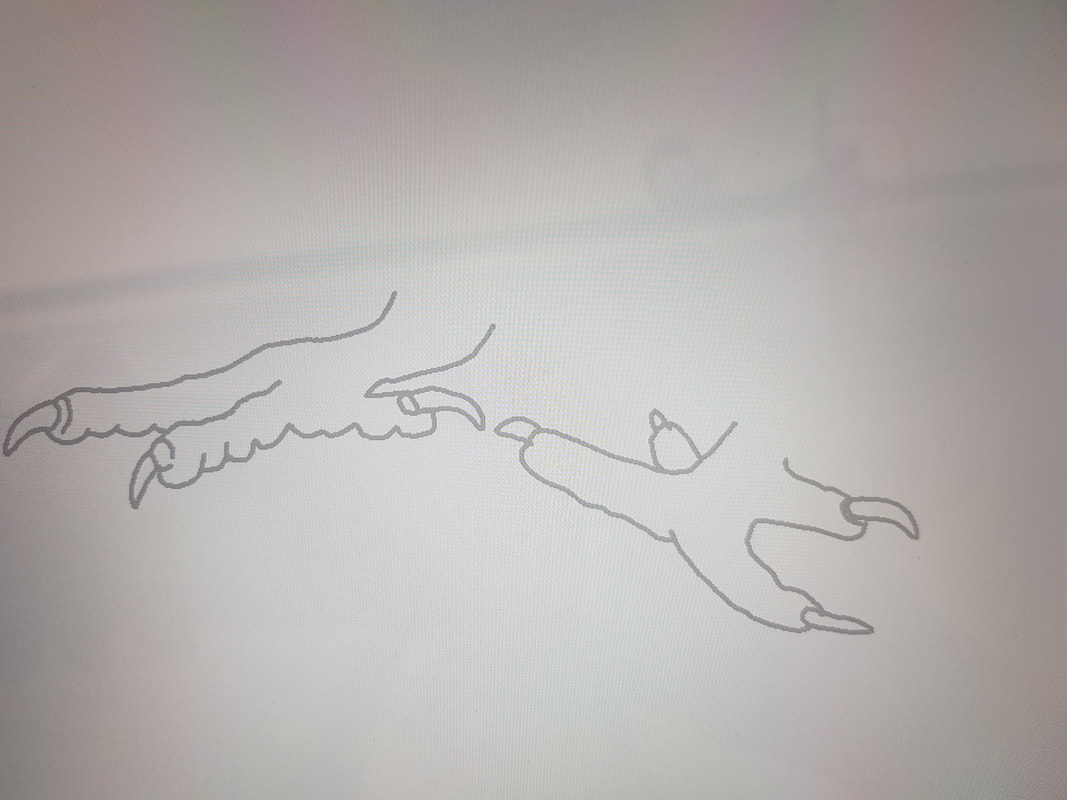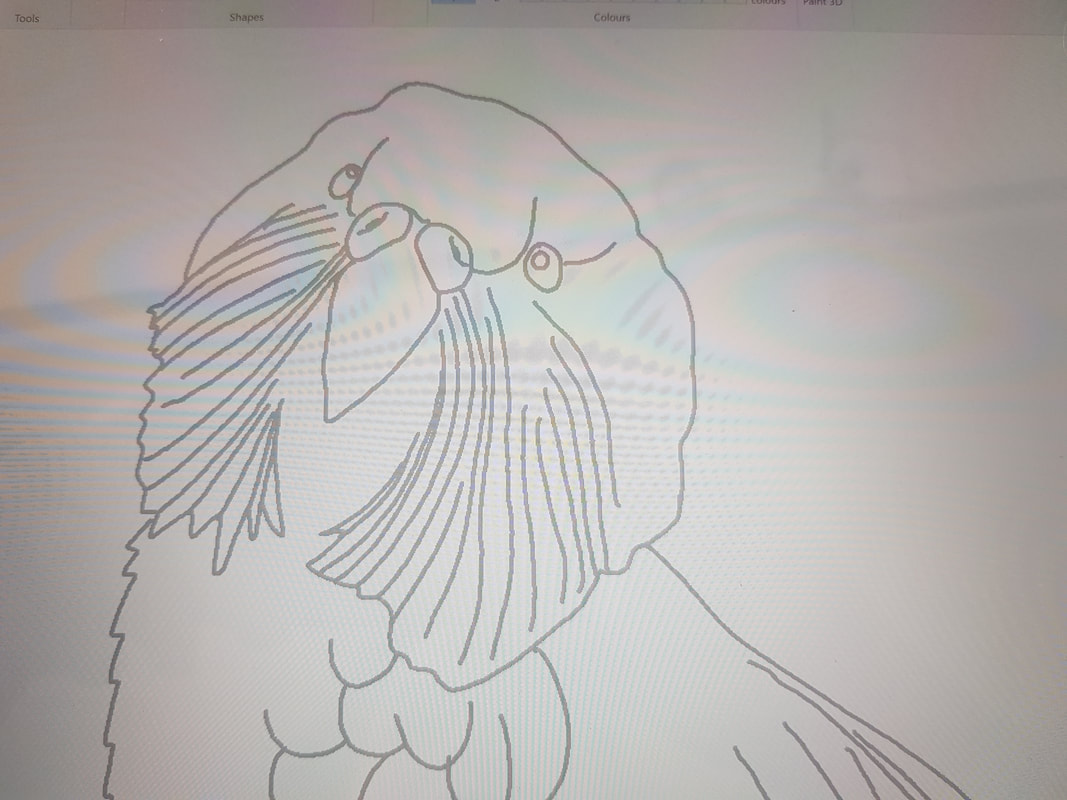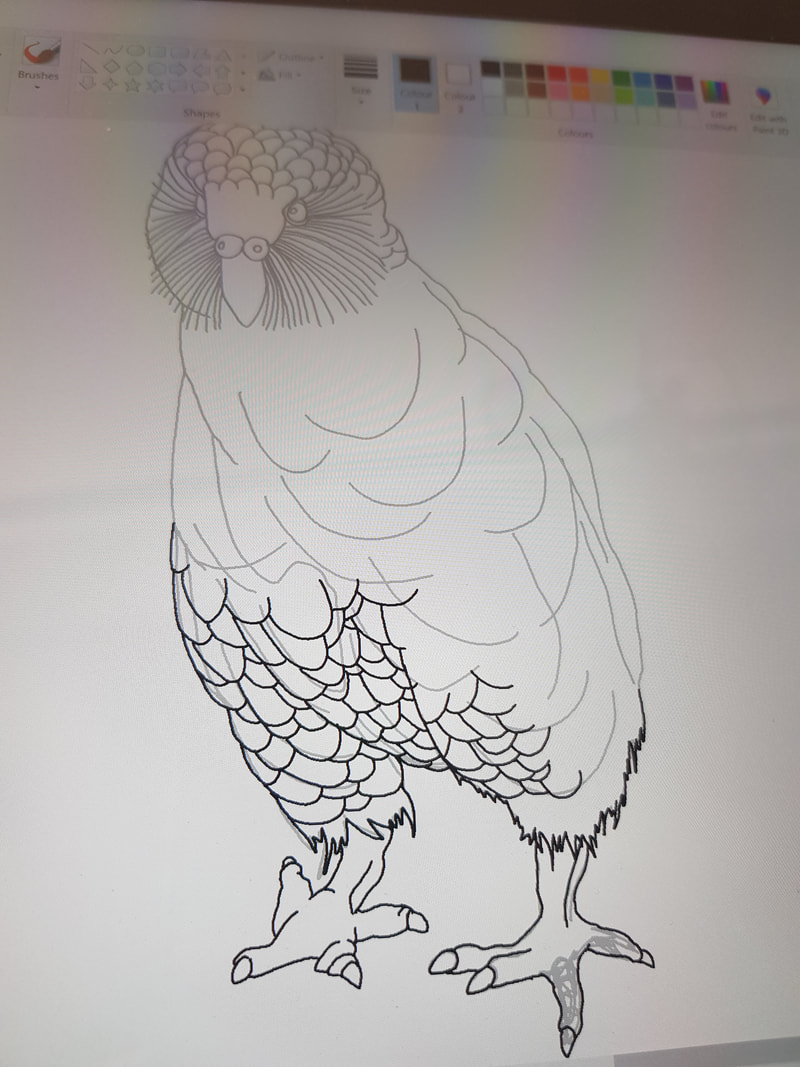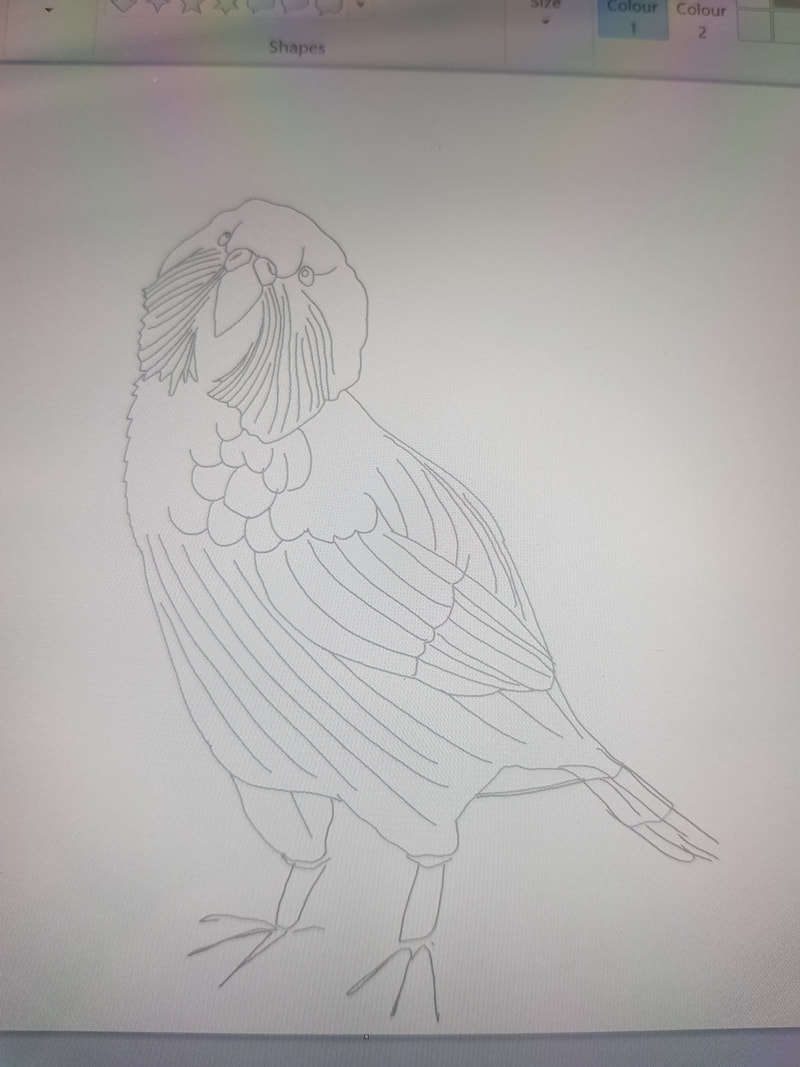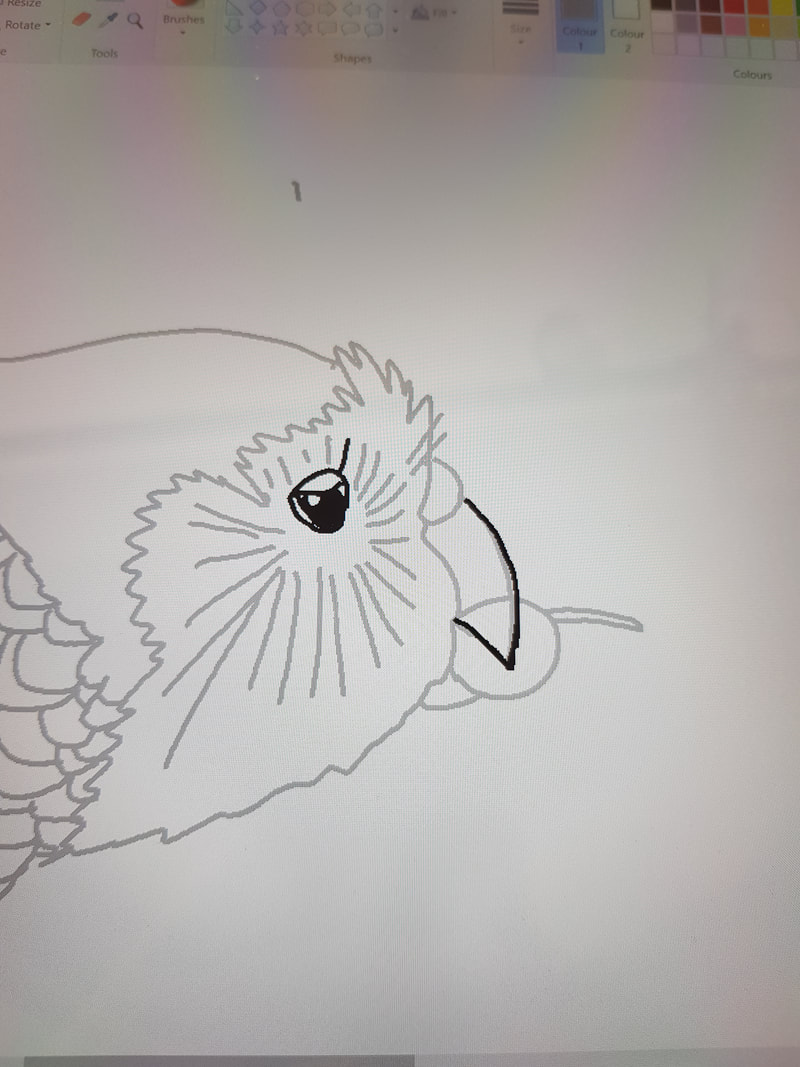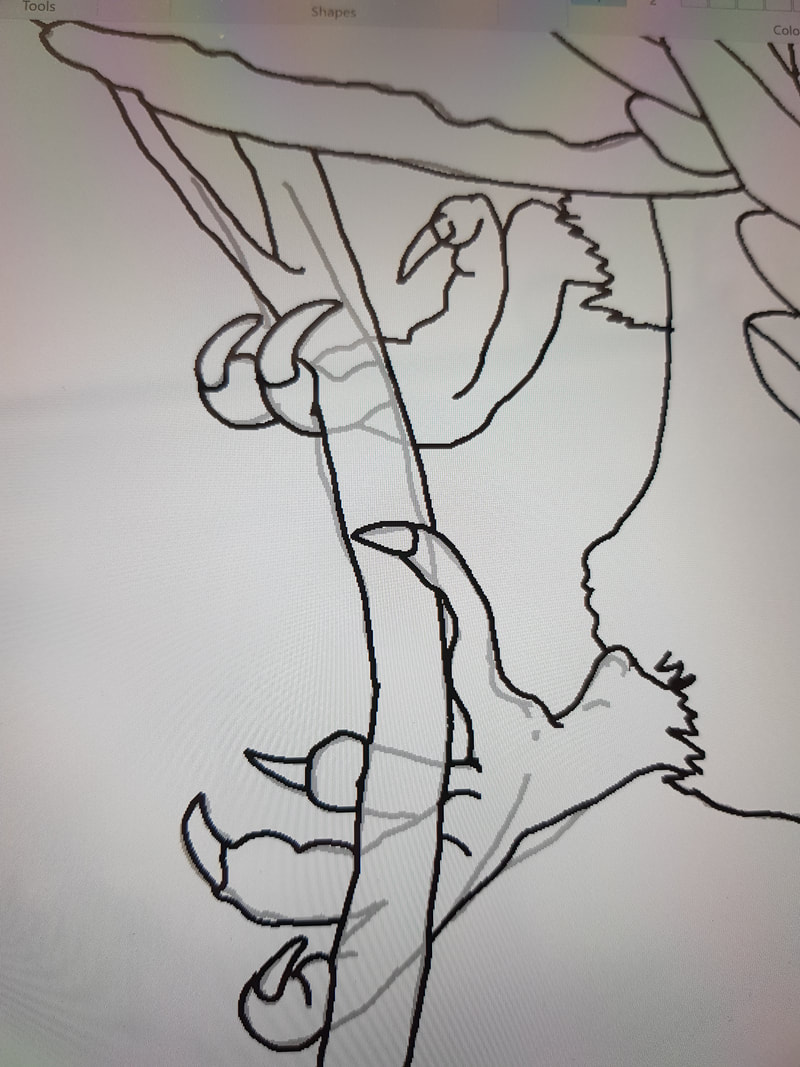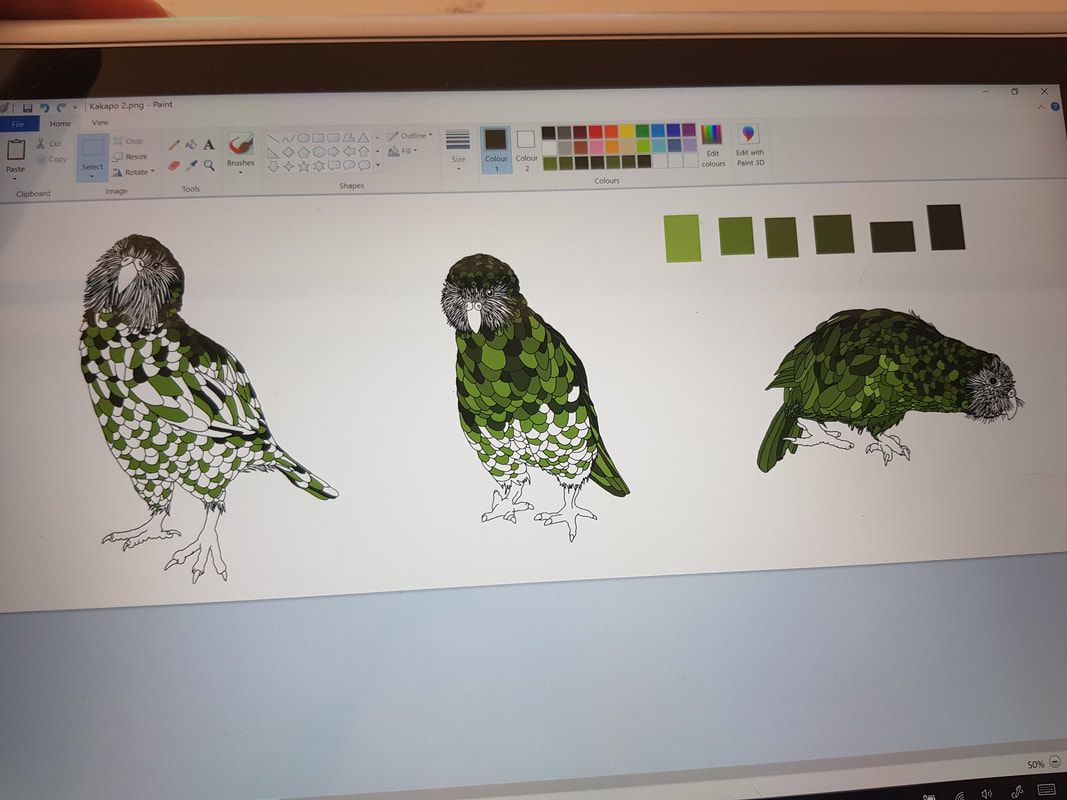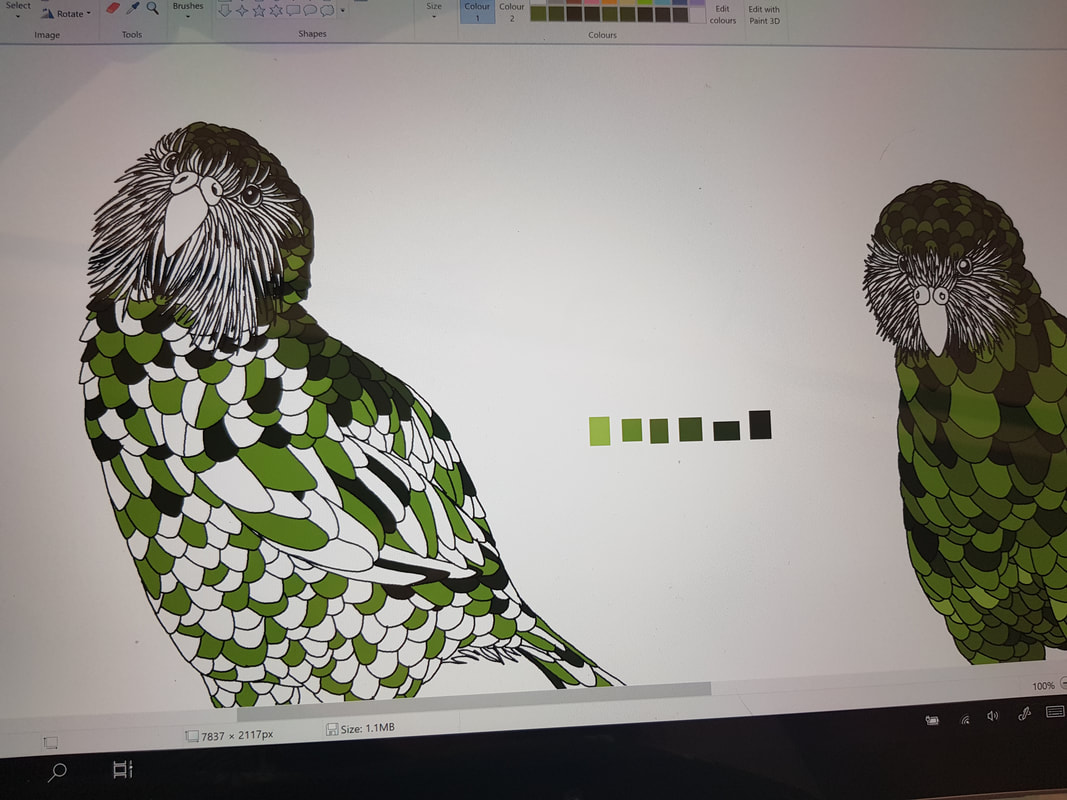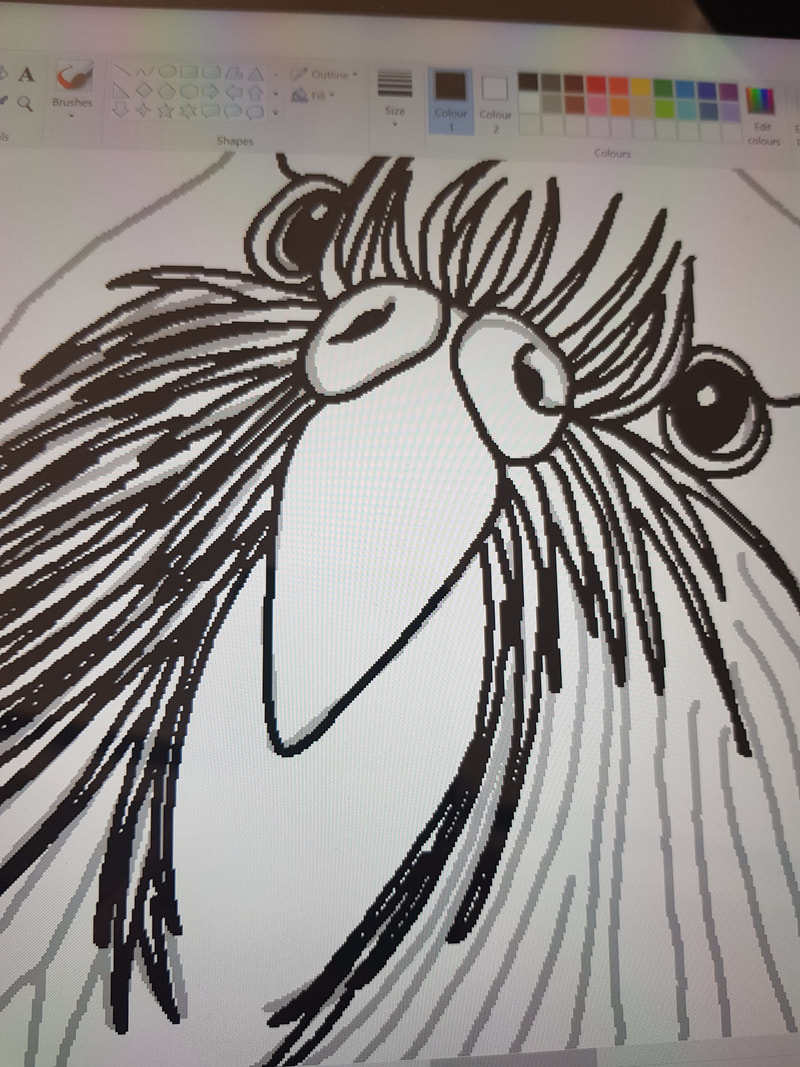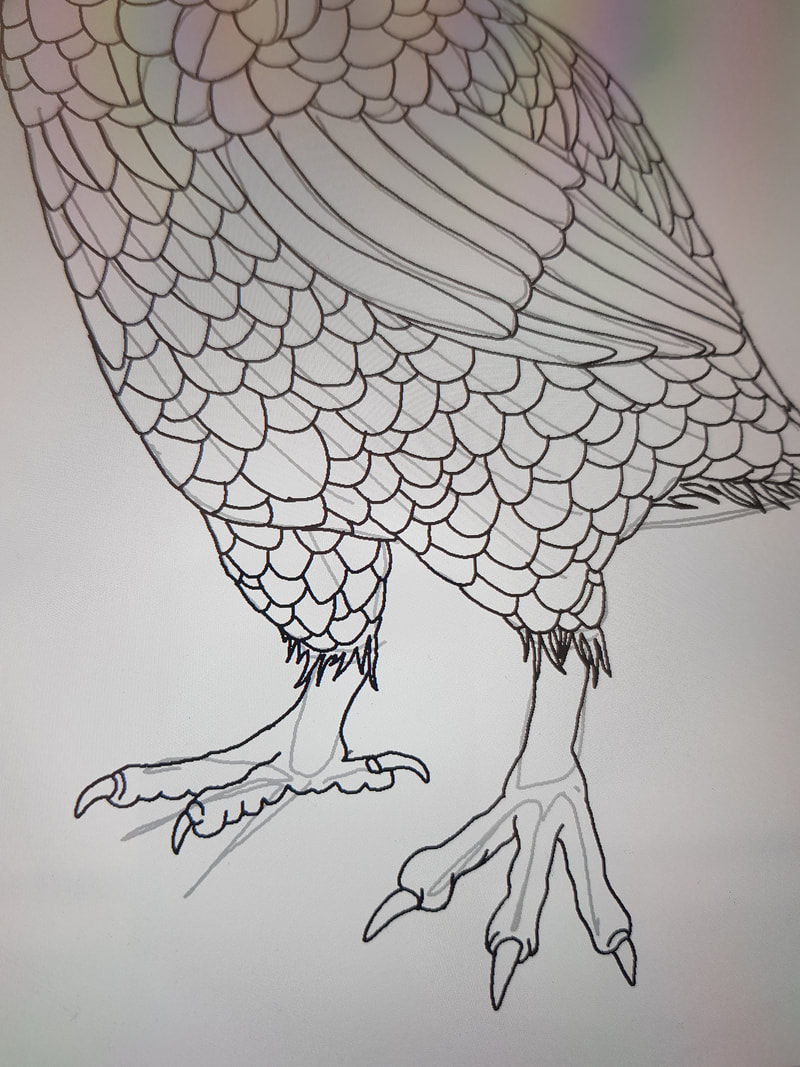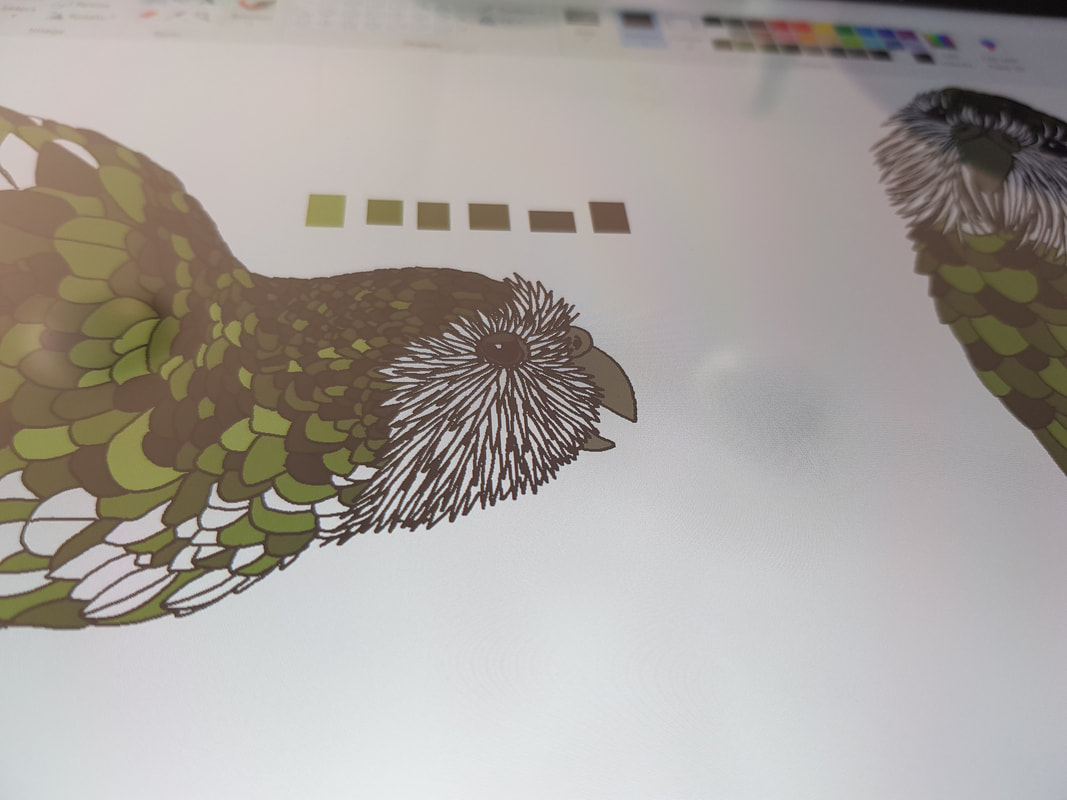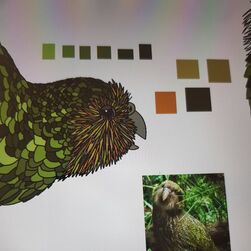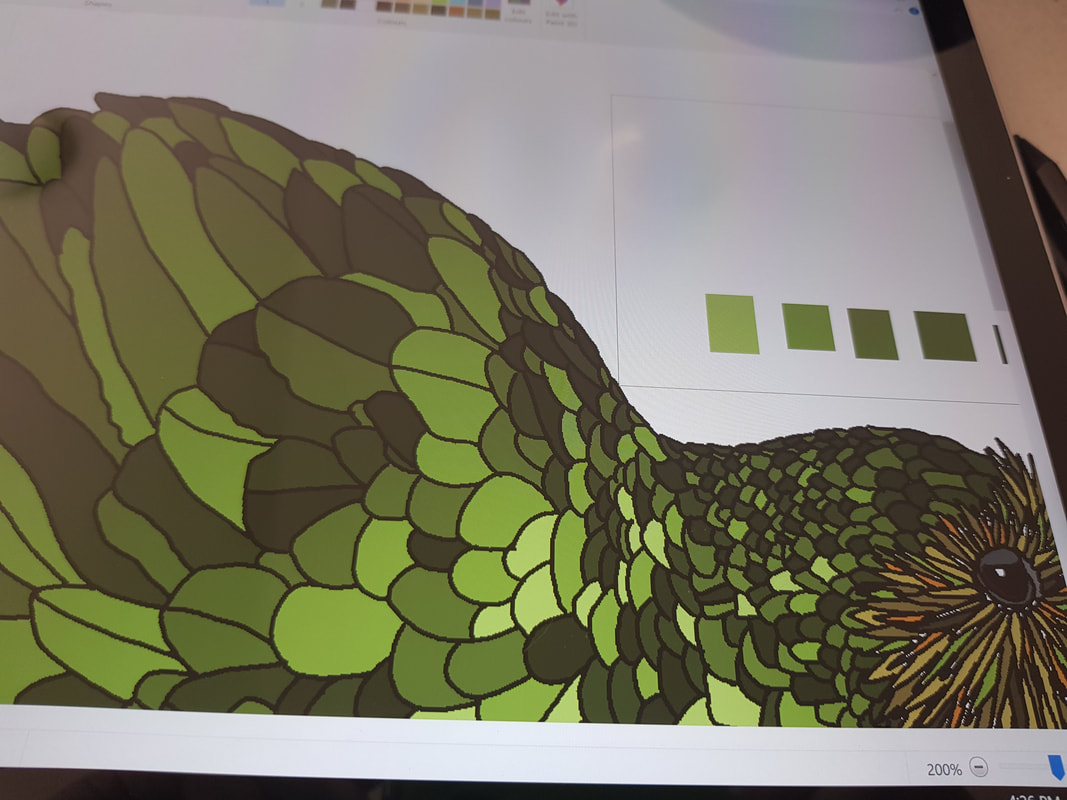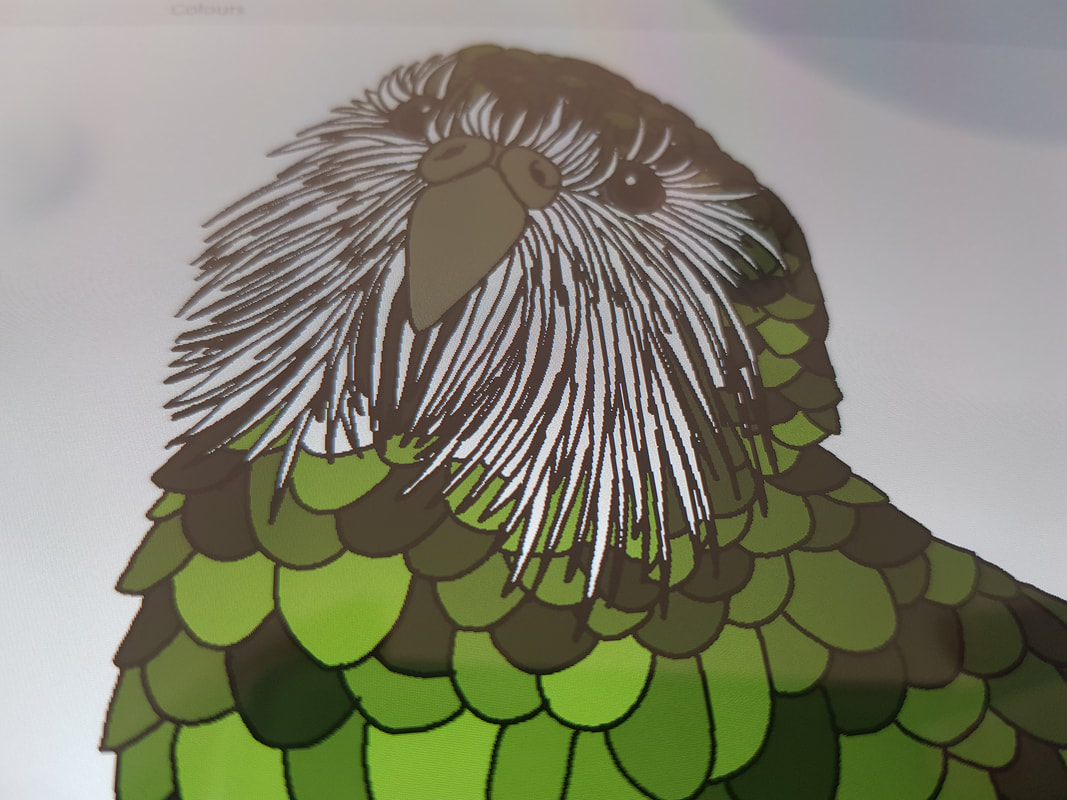Parrots of Aotearoa
There are quite a few species of parrot in New Zealand, some of which are sadly extinct. There are nine surviving species which are endemic to NZ. Two of these species are on our list of the
Threatened–Nationally Critical birds to draw in this series (shown in bold). Sadly, several others are also endangered.
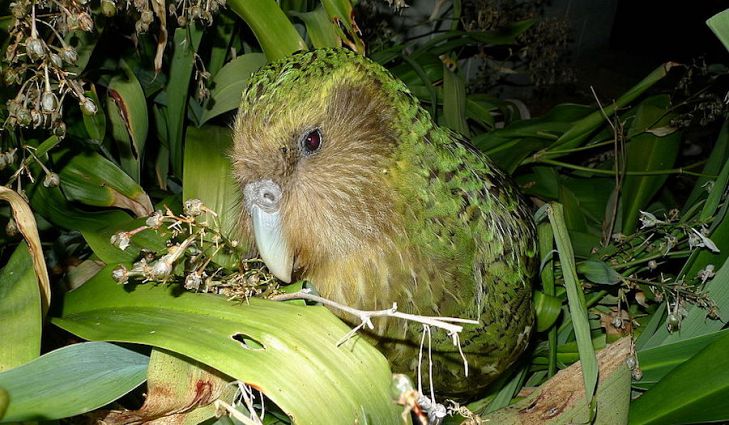
The kakapo (Strigops habroptilus)
|
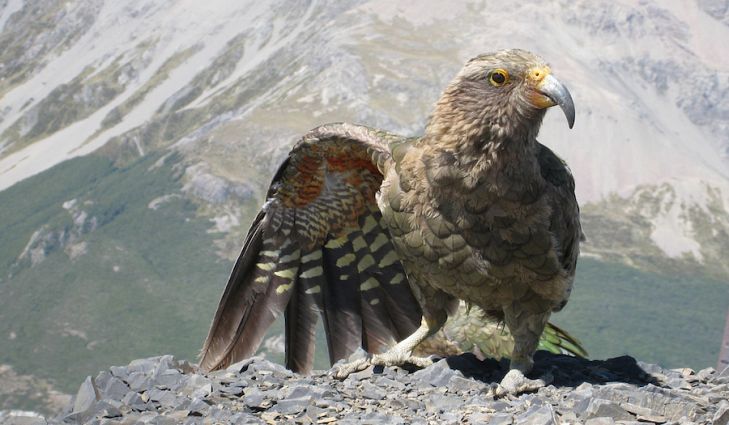
The kea (Nestor notabilis)
|
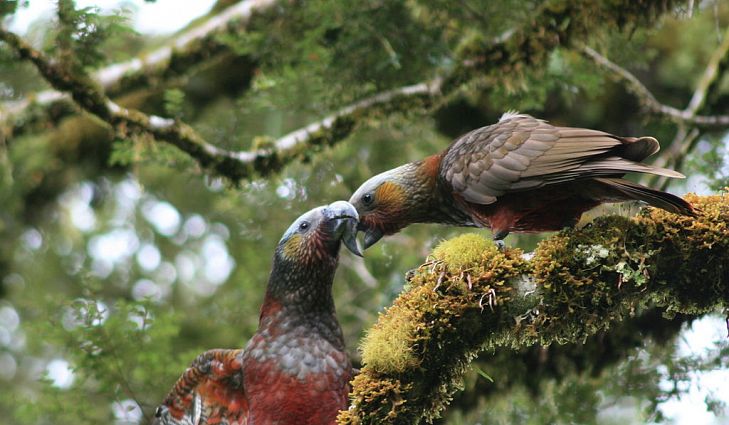
The New Zealand kaka (Nestor meridionalis).
|
These species live on the mainland:
- the kea (Nestor notabilis)
- the New Zealand kaka (Nestor meridionalis)
-
the kākāpō (Strigops habroptilus) – Threatened–Nationally Critical
- three species of kākāriki:
- the yellow-crowned parakeet (Cyanoramphus auriceps),
- the red-crowned parakeet (Cyanoramphus novaezelandiae)
-
the orange-fronted parakeet (Cyanoramphus malherbi) – Threatened–Nationally Critical
Source:
Wikipedia
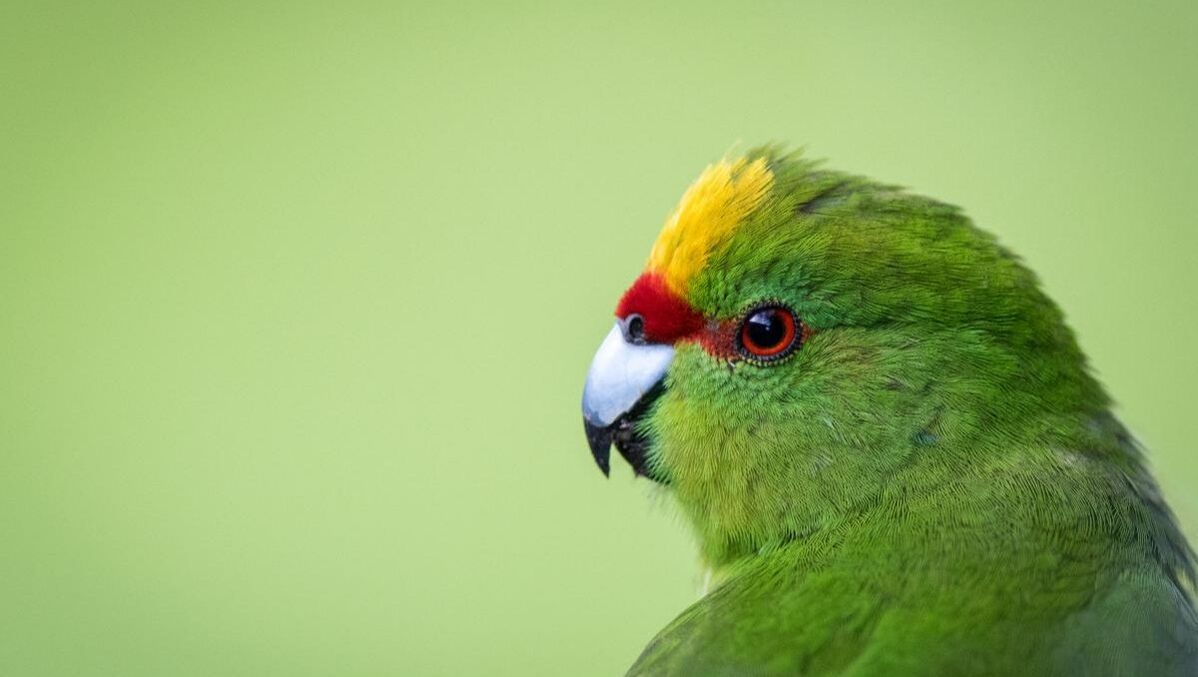
Yellow-crowned parakeet. Headshot of adult bird. Mana Island, November 2016. Image © Leon Berard by Leon Berard
|
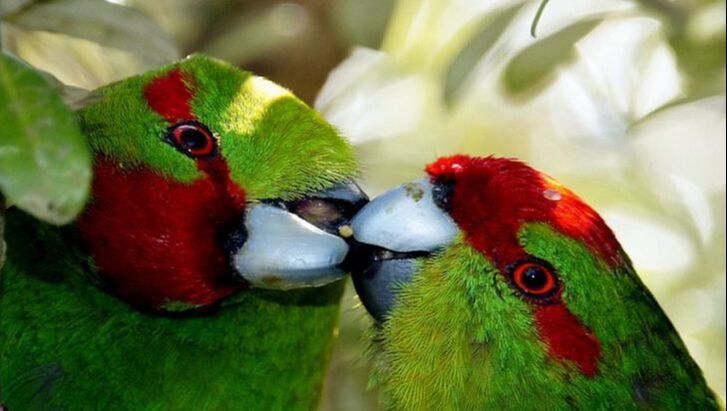
The red-crowned parakeet (Cyanoramphus novaezelandiae)
|
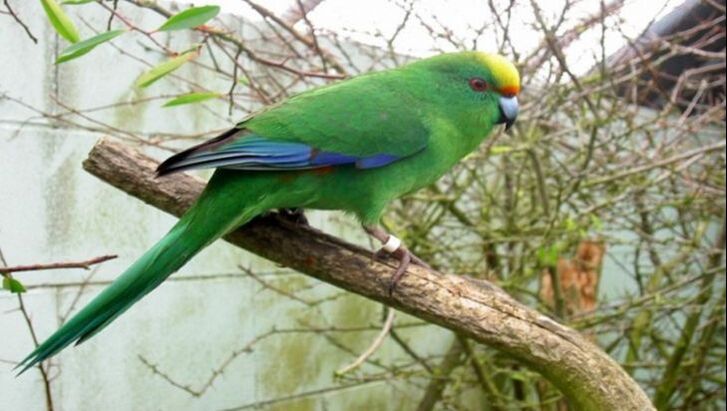
The Malherbe’s parakeet, also known as the orange-fronted parakeet (Cyanoramphus malherbi)
|
These are the island species:
- the Chatham parakeet or Forbes’ parakeet (Cyanoramphus forbesi), from the Chatham Islands
- the Antipodes parakeet (Cyanoramphus unicolor), endemic to Antipodes Island
- Reischek’s parakeet (Cyanoramphus hochstetteri), endemic to Antipodes Island
Source:
Wikipedia
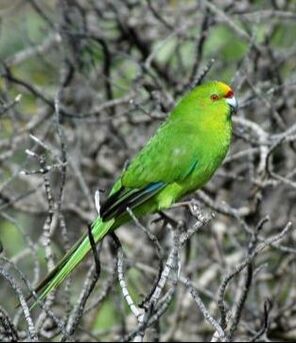
Forbes’ parakeet. Adult. Mangere Island, Chatham Islands, September 2009. Image © Department of Conservation (image ref: 10066569) by Don Merton, Department of Conservation Courtesy of Department of Conservation
|
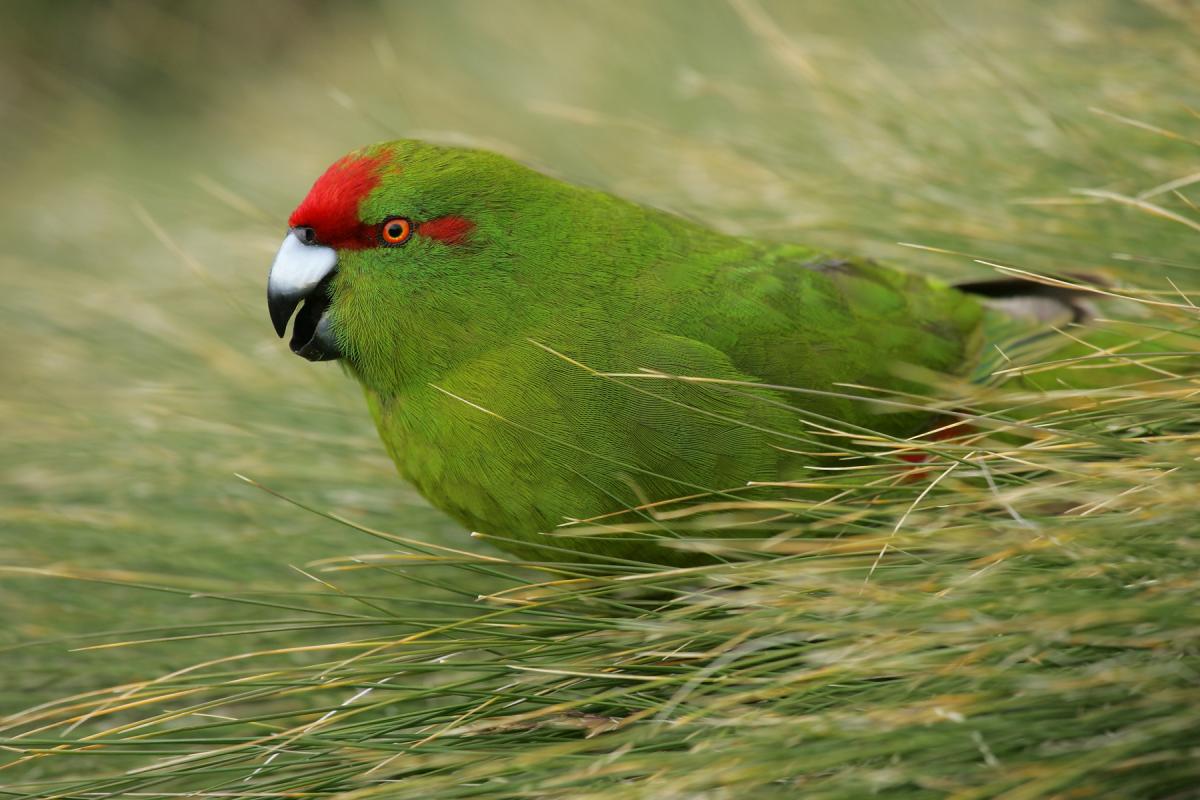
Reischek’s parakeet. Adult. Antipodes Island, December 2009. Image © David Boyle by David Boyle
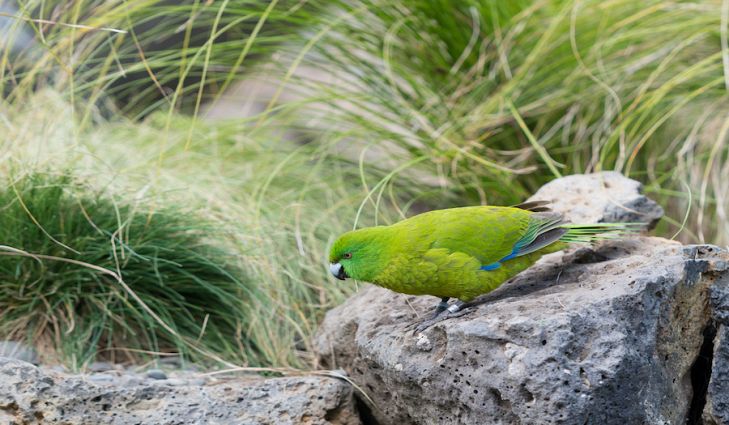
Antipodes Island parakeet
|
Extinct endemic species:
- the Norfolk Island kaka (Nestor productus), extinct by 1851, from Norfolk Island
- the Chatham kaka (Nestor chathamensis), extinct by 1550–1700, from the Chatham Islands
- Unidentified parakeet, extinct by 1840, from Campbell Island
Introduced Australian species:
- the eastern rosella (Platycercus eximius) – significant self-sustaining populations
- the sulphur-crested cockatoo (Cacatua galerita) – significant self-sustaining populations
- the crimson rosella (Platycercus elegans) – smaller numbers
- the Galahs (Eolophus roseicapilla) – smaller numbers
- the rainbow lorikeet (Trichoglossus moluccanus) – ‘unwanted organism’ under the Biosecurity Act
Source:
Wikipedia
Kākāpō
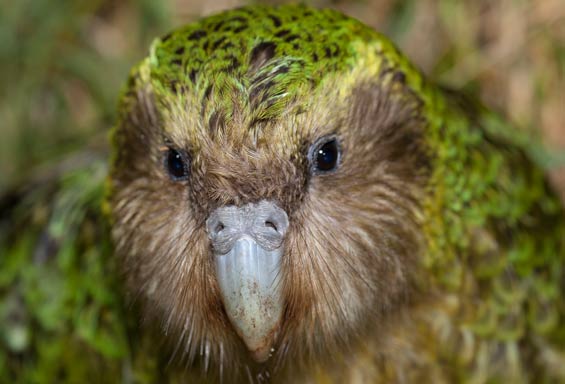
Sirocco
On the internet, kākāpō are famous for the notorious head-shagging incident when Stephen Fry met
Sirocco on the BBC.
(Sirocco is) a charismatic kākāpō, national treasure and media superstar. He’s also New Zealand’s official Spokesbird for conservation.
Sirocco rocketed to fame in 2009 after his encounter with zoologist Mark Carwardine became a YouTube sensation. Carwardine was filming the BBC documentary Last Chance to See with British actor Stephen Fry. Footage showed a rather frisky Sirocco attempting to mate with Carwardine’s head as Fry laughed from the sidelines.
Source:
DOC
Sources and resources
The common English name “kakapo” comes from the Māori “kākāpō”, from kākā (“parrot”) + pō (“night”); the name is both singular and plural. “Kākāpō” is increasingly written in New Zealand English with the macrons that indicate long vowels.
[…]The kakapo is the only extant species of flightless parrot in the world, and the only flightless bird that has a lek breeding system.[35] Males loosely gather in an arena and compete with each other to attract females. Females listen to the males as they display, or “lek”. They choose a mate based on the quality of his display; they are not pursued by the males in any overt way. No pair bond is formed; males and females meet only to mate.Source:
Wikipedia
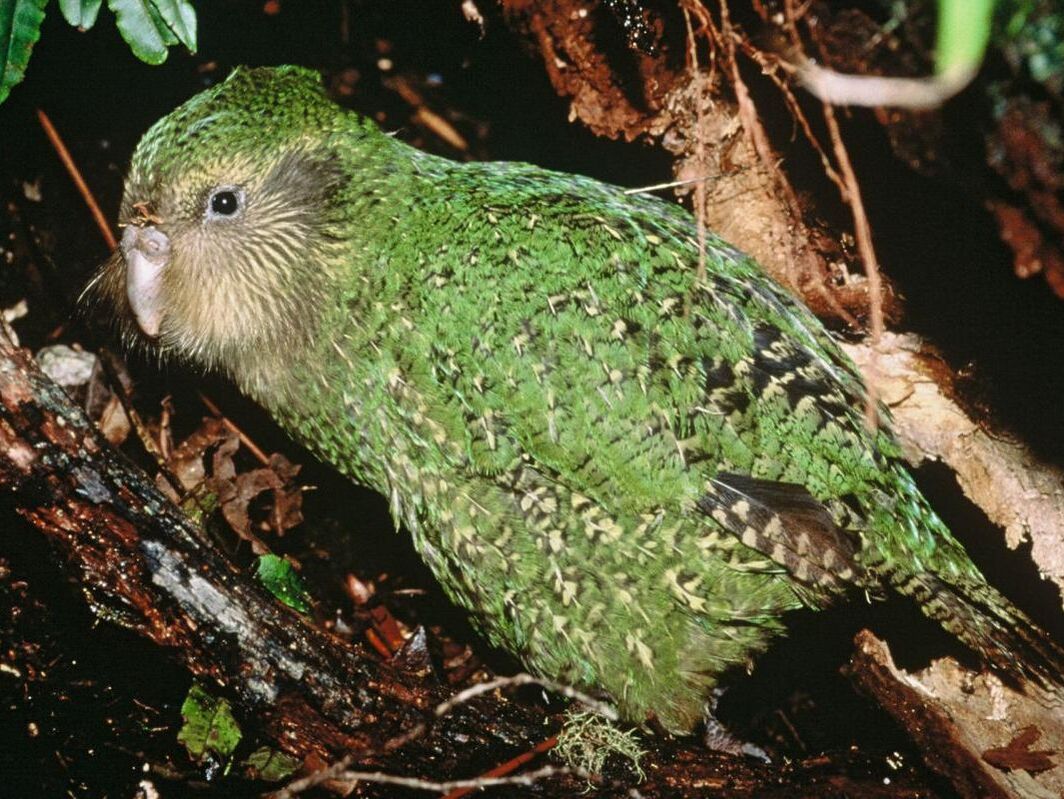
Kakapo. Juvenile ‘Manu’ (75 days old). Whenua Hou / Codfish Island, June 1997. Image © Department of Conservation (image ref: 10036011) by Don Merton, Department of Conservation Courtesy of Department of Conservation
|
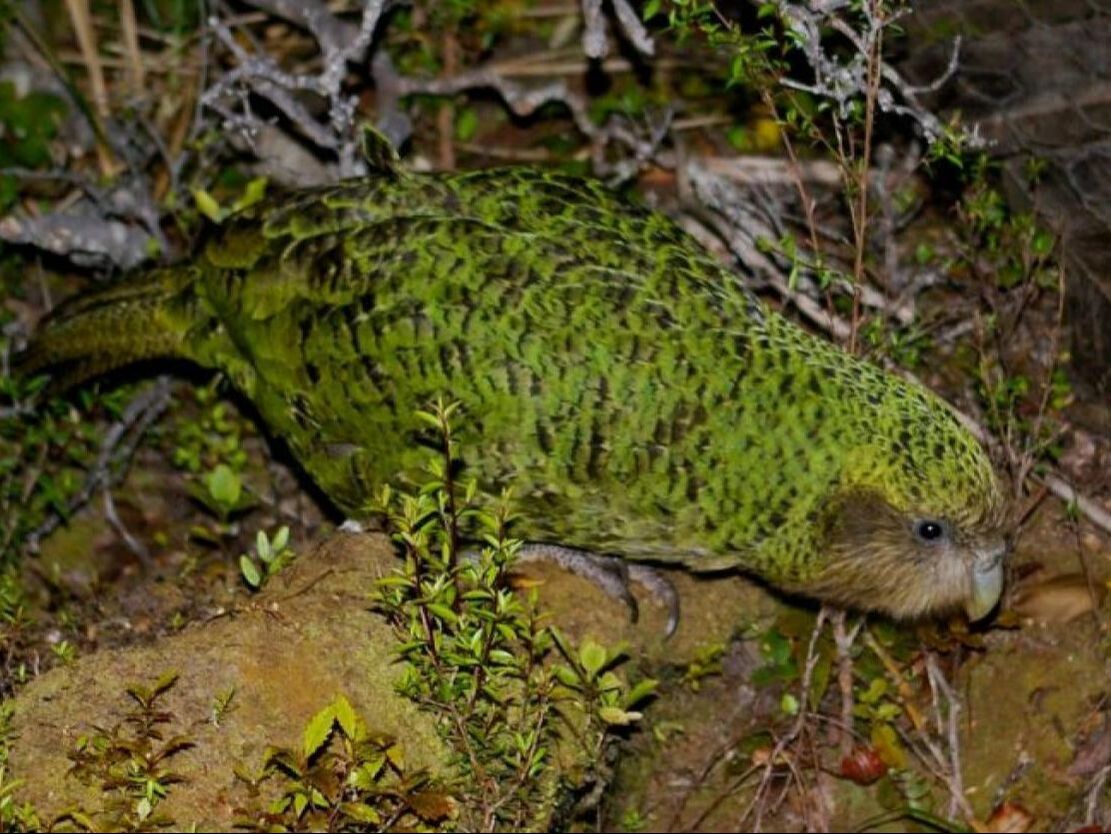
Kakapo. Adult. Codfish Island, December 2011. Image © Colin Miskelly by Colin Miskelly
|
The kakapo is a large, nocturnal, flightless, lek-breeding parrot – a real oddity. It is also critically endangered, and the focus of considerable conservation attention. Before humans arrived it was common throughout New Zealand’s forests, but predation by introduced mammals brought it to the brink of extinction – a low point of about 50 birds only in the mid 1990s. The transfer of the whole population to predator-free islands and intensive intervention in every stage of its life has led to a steady increase in numbers.
Kakapo have no close relatives.
Source:
NZ birds online
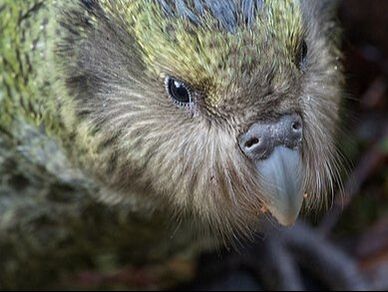
Juvenile kākāpō (Strigops habroptilus) on Anchor Island in Dusky Sound, New Zealand, Kimberley Collins – https://www.flickr.com/photos/114706196@N08/42241568542/
|
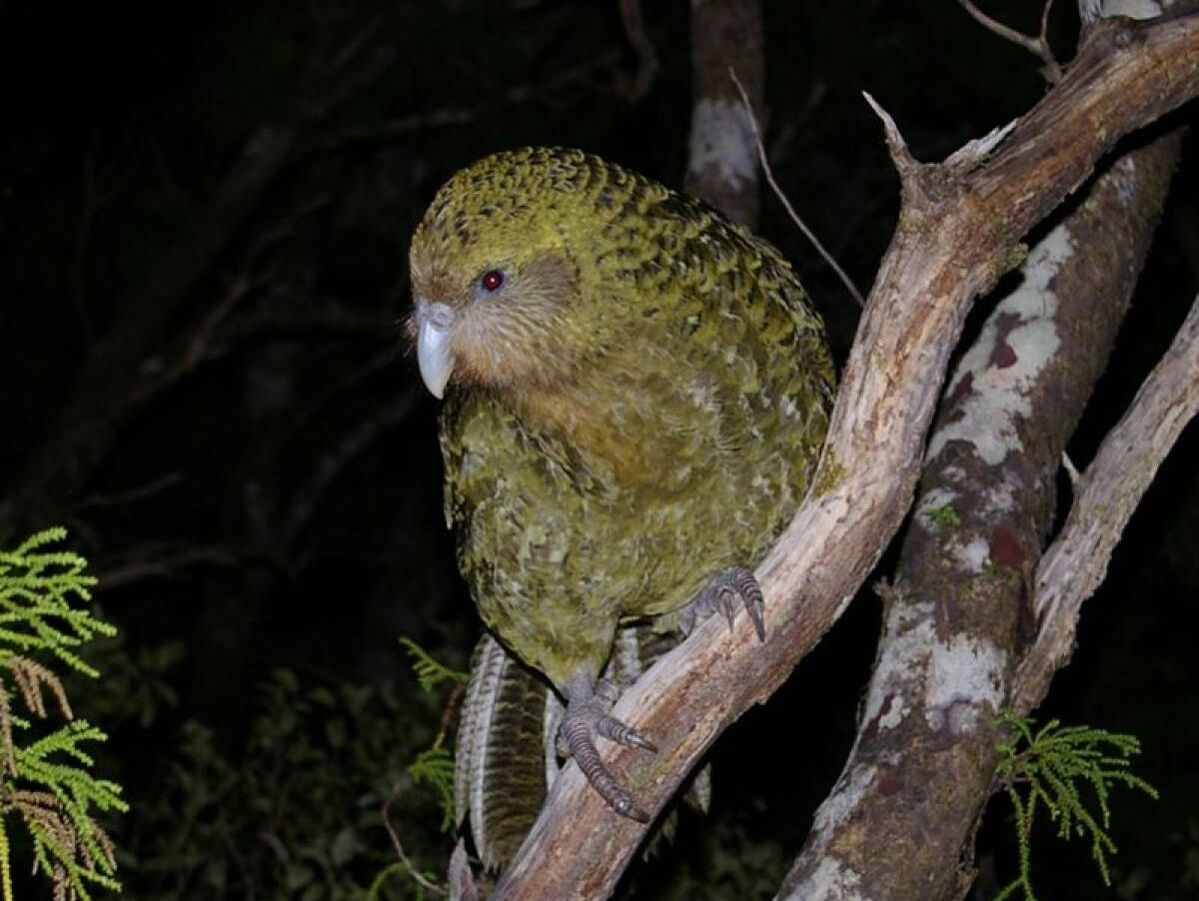
Kakapo. Adult. Anchor Island, March 2011. Image © Colin Miskelly by Colin Miskelly
|
What’s unusual about kākāpō?
The kākāpō is a large green parrot with a distinctive owl-like face and a waddling gait. They cannot fly, but they climb well.
Kākāpō are:
- nocturnal
- flightless
- the only lek-breeding parrot species in the world
- perhaps the longest-lived bird species in the world, estimated to reach 90 years
- the heaviest parrot species in the world – smaller females weigh 1.4 kg, and males 2.2 kg. And they can pile on 1 kg of fat prior to a breeding season.
Source:
DOC
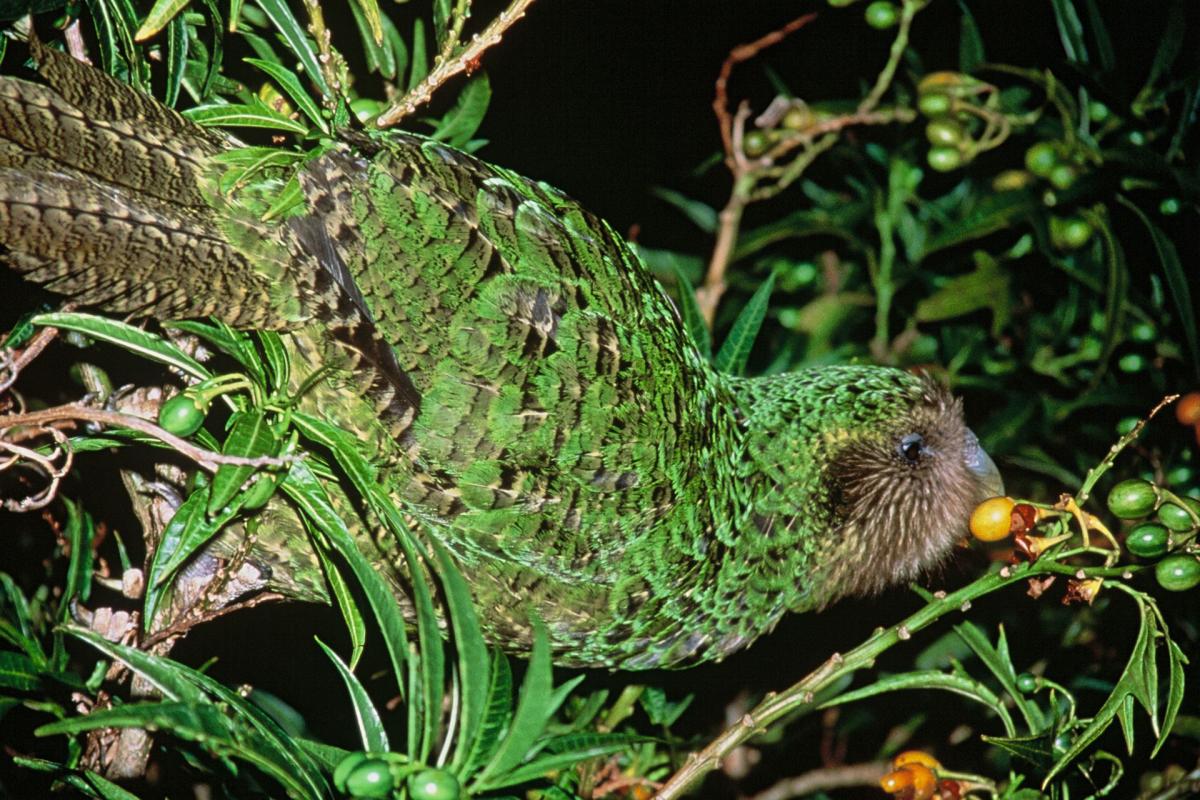
Kakapo. 2-year-old male ‘Trevor’ feeding on ripe poroporo fruit. Maud Island, March 2001. Image © Department of Conservation (image ref: 10047127) by Don Merton, Department of Conservation Courtesy of Department of Conservation
|
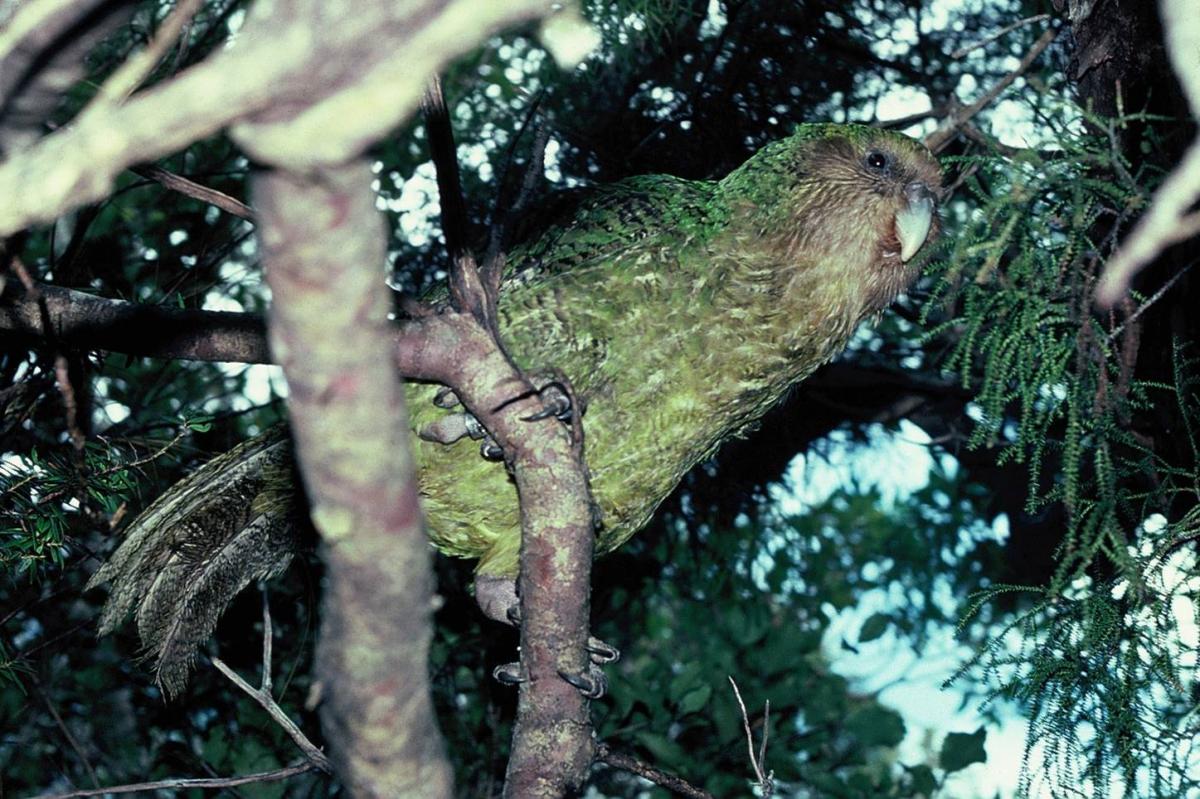
Kakapo. Adult ‘Lionel’ in tree. Stewart Island, December 1983. Image © Alan Tennyson by Alan Tennyson
|
Anatomy of a parrot
Right, time to focus in on the task at hand – drawing the kākāpō. So, how do they fit together?
The skeleton of the kakapo differs from other parrots in several features associated with flightlessness. Firstly, it has the smallest relative wing size of any parrot. Its wing feathers are shorter, more rounded, less asymmetrical, and have fewer distal barbules to lock the feathers together. […] The kakapo has a larger pelvis than other parrots. The proximal bones of the leg and arm are disproportionately long and the distal elements are disproportionately short.
Source:
Wikipedia
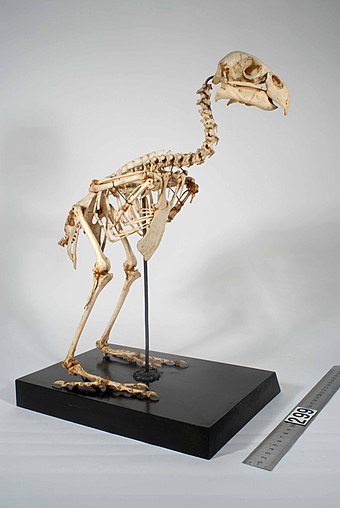
Kākāpō skeleton, Auckland museum
|
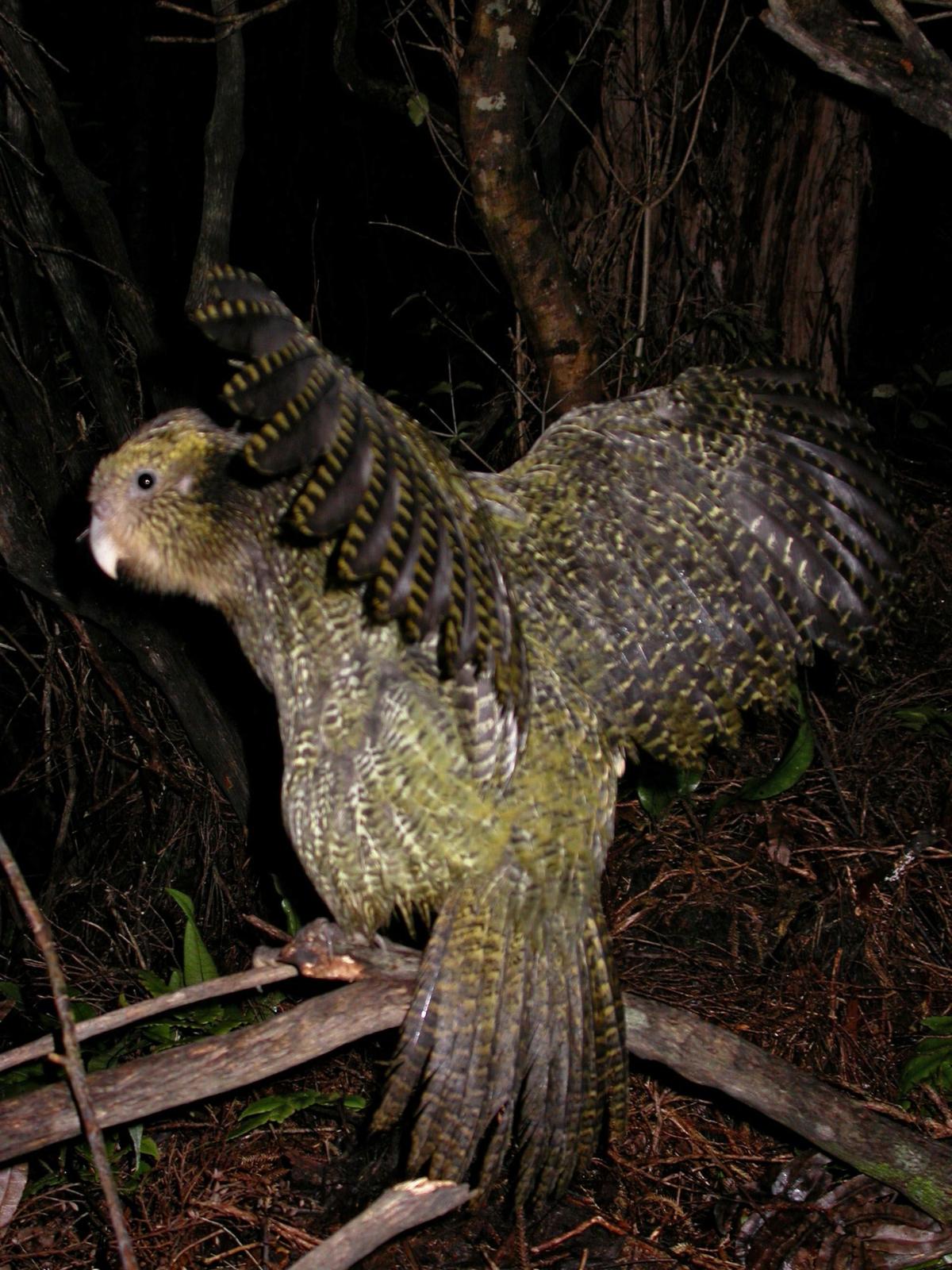
Kakapo. Female bird waving wings. Whenua Hou / Codfish Island. Image © Department of Conservation (image ref: 10059610) by Michael Szabo, Department of Conservation Courtesy of Department of Conservation
|
OK, so that was a lot of scientific jargon. Basically, little wings, fewer wing feathers, odd leg proportions, and not much of a chest. Got it.
Initial sketches
I had a dental procedure under IV sedation today, so while I now have a shiny new tooth, I have spent the day groggy and weird – which is not, unfortunately, conducive to drawing parrots. I have a good idea of what I want to do, but no energy left to do it – so this is where I am stopping for the night.
So I filled out the sketches, and decided that I would develop four into the final designs.
Choosing the colours was fun – and I made sure to keep the palette simple.
It was a lot of fun getting the silly expressions on these funny wee faces. I think they came out ok, too!
Colouring feather by feather took a really long time, though – but I think it looks pretty effective.




















